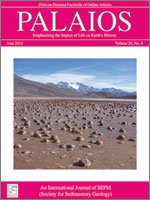Burgess Shale–type deposits represent exceptional preservational windows for examining the biodiversity and ecological structure of some of the earliest metazoan communities that evolved during the Cambrian Explosion. While much attention has been paid to the original Burgess Shale locality, the Walcott Quarry on Fossil Ridge, temporal and regional variations of the depositional environment of the Burgess Shale biota as a whole are still poorly understood. Here we present the first comprehensive taphonomic and sedimentological study of the Tulip Beds on Mount Stephen (Campsite Cliff Shale Member, Burgess Shale Formation), based on a time-averaged assemblage of nearly 10,000 specimens. The taphonomic characteristics—size sorting, resistance to decay, and potential flow alignment—and mode of deposition of this assemblage are compared specifically to those of the nearby and stratigraphically younger Walcott Quarry assemblage. Like other Burgess Shale–type deposits, the Tulip Beds consist of millimeter-laminated, event-derived claystone, but lack the thicker claystone layers and prominent carbonate interbeds that occur in the Walcott Quarry. These differences suggest a depositional environment lower in energy and possibly more distal to the Cathedral Escarpment. Overall, taphonomic analyses suggest no significant decay biases, transport, or sorting of the assemblage, and most specimens, benthic taxa in particular, appear to have been buried close to their living environments. Single bedding planes with large accumulations dominated by a single taxon, e.g., isolated claws of Anomalocaris, suggest short time-averaged assemblages with limited background sedimentation. Overall the Tulip Beds locality is environmentally and taphonomically comparable to the Walcott Quarry and biotic variations between the two sites are likely to be primary in nature, thus paving the way for more detailed paleoecological investigations in the future.
How to translate text using browser tools
1 June 2014
TAPHONOMY AND DEPOSITIONAL SETTING OF THE BURGESS SHALE TULIP BEDS, MOUNT STEPHEN, BRITISH COLUMBIA
LORNA J. O'BRIEN,
JEAN-BERNARD CARON,
ROBERT R. GAINES
ACCESS THE FULL ARTICLE
It is not available for individual sale.
This article is only available to subscribers.
It is not available for individual sale.
It is not available for individual sale.
<
Previous Article
|

PALAIOS
Vol. 29 • No. 6
June 2014
Vol. 29 • No. 6
June 2014




